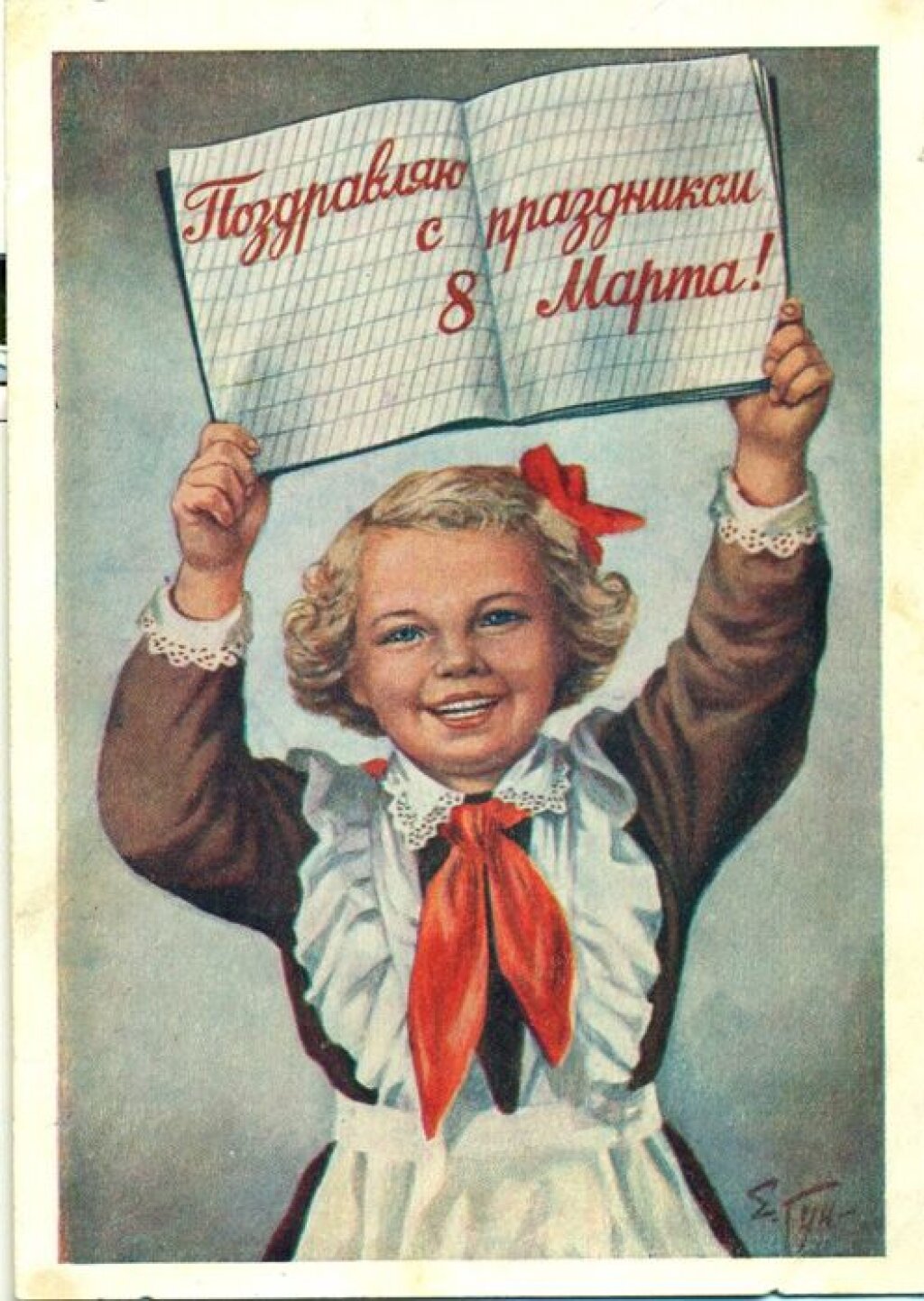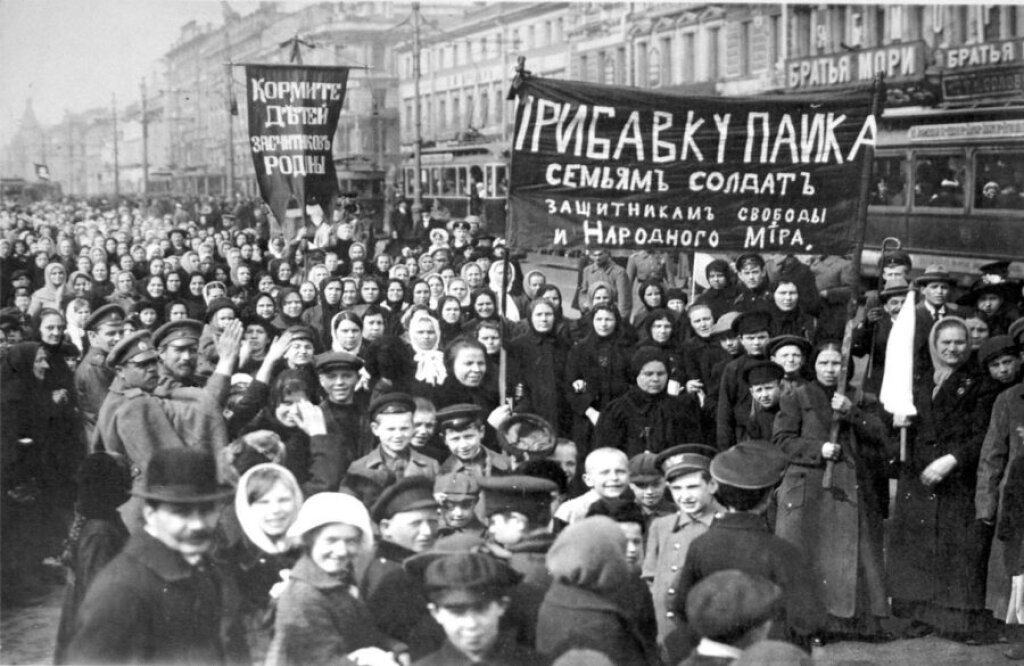This post features a runner-up entry in
All the Russias'
inaugural
Graduate Student Essay Competition
.
Zinaida Osipova is an M.A. student in History at Miami University interested in cultural history of the early Soviet Union.
Today is International Women’s Day. While many countries honor the date by celebrating women’s empowerment and gender equality, in Russia, it is a day when women — relatives, colleagues, friends, and significant others — receive flowers, chocolate, perfume, and other “feminine” gifts, thus reaffirming rather than bridging the traditional gender divide.
The contrast between the day's theoretical and practical implications is remarkable considering Russia’s historic place at the forefront of promoting women’s equality in politics and labor (in ideology if not in reality). The peculiar transition of International Women’s Day from a symbol of equality to a celebration of traditional womanhood occurred in the late Soviet period, during the 1970s and '80s. Examining March-8th dispatches in
Pravda
between 1920 and 1991 reveals a gradual shift in the official feminine ideal: at first, women were glorified as fellow workers and builders of socialism; in time, however,
Pravda
began promoting first female patriots and peace advocates, then figures representing motherly love and care.
On March 8th, 1917 (or February 23rd, according to the Julian calendar), amid Russia’s exhaustion from the Great War, the country’s women took to the streets demanding bread. This event gave rise to the February Revolution, which ended 300 years of Romanov dynasty rule and opened a power vacuum eventually filled by the Bolsheviks. Shortly after the Revolution, Russia became one of the first countries to grant women voting rights and legalize abortion, while also adopting progressive policies that allowed women to engage in productive labor.
How did the image of the ideal Soviet woman revert from productive laborer to tender mother?
Initially, the Soviet state saw March 8th as the “Female Workers’ Day,” an opportunity to emphasize the productive labor of its female citizens. In the 1920s, Pravda declared that “to eradicate exploitation of women, it is necessary to vanquish capitalism” and to “help the female worker of the capitalist countries in her fight” for socialism (1922-1923). Meanwhile, the USSR was to “raise the cultural level” of female workers and peasants, involving them in both management tasks and the building of socialism itself (1926). In the 1920s, March 8th was also a day to take pride in the fact that “a [Soviet] female worker enjoys the greatest freedom [and] has the most rights” (1927).
In the 1930s, in addition to discussing the benefits afforded to “the happy women of the Soviet country” (1939), Pravda stressed the USSR’s superiority over fascist regimes in terms of its treatment of women. “Female workers, unmask the vile face of social fascism!” the newspaper proclaimed in 1931. By 1934, the March 8th issue of Pravda featured Joseph Goebbels's statement that a woman must be “beautiful and bear children for her husband," followed by a denunciation of this rival to Soviet ideology.
The newspaper stressed the progressive nature of the Soviet system, which provided canteens and child care institutions that liberated women from the “ignominious and numbing" duties of "hearth and home [domashnii ochag].” By contrast, Pravda claimed, “fascist ideologists” told women that their place was precisely in this “hearth and home” (1933, 1936). In the 1930s, “International Communist Women’s Day” symbolized Soviet women’s superior position vis-à-vis their capitalist counterparts, rallying them to work in fulfillment of Five-Year Plans and mass collectivization drives (1932).
Unsurprisingly, the 1940s saw Pravda highlighting Soviet women’s war efforts at the front and at home, publishing reassuring messages to the effect that Soviet women would give their all to defeat German invaders. In addition to women’s patriotism, postwar issues of the newspaper discussed Soviet women’s active participation in various professions, including politics: the 1946 and 1949 issues, for instance, published statistics on the high number of women-deputies, thus pointing to Soviet primacy in the endeavor towards gender equality and upholding original values of March 8th.
In the 1950s, Pravda continued to affirm the progressive nature of Soviet society, addressing itself to “female workers, collective farmers, workers [in the fields of] science, technology, education, culture and healthcare of the Soviet Union” (1957-1959). If 1930s-era Pravda had expressed anxieties about fascism, the 1950s version of the paper focused on Cold War issues. In its discussion of the contemporary arms race, Pravda stated that the women of the world demanded their rights and the “rejection of the use of atomic, hydrogen, and other types of mass destruction of people” (1954). The paper pointed to women’s “fighting for peace in the entire world” and advocating for “arms reduction” (1955, 1957), thus using a March 8th to drum up support for contemporary issues — partly by portraying women as natural peacemakers.
In the 1960s, Pravda continued to underscore putatively emancipatory improvements in household and childcare services, which would ostensibly liberate female workers from “hard domestic work” (1968). As in the 1950s, the newspaper promoted the image of women as peacemakers who yearned for resolution of all global conflicts. Per Pravda, most women clamored for an “immediate end to the military intervention of American imperialism” in Vietnam (1966) and expressed joy at burgeoning independence movements in Asia, Africa, and Latin America (1963-1964). The Central Committee, for its part, hailed women’s childrearing activities and wished them success in all their endeavors: “good health, a joyous, and peaceful life” (1966, 1968). It also made March 8th a public holiday.
Although Pravda had always stressed the societal importance of women as mothers, the 1970s saw a softening of the language used to address them. The rhetoric of Soviet primacy in gender equality remained, but the newspaper now began emphasizing stereotypically feminine qualities like “generosity of heart” and “motherly wisdom” (1975, 1977). Pravda noted women’s “moral beauty, caring hands, warmth of heart” and suggested that industry was in need of said “caring hands," along with women's "inquisitive minds, hostess’s [khoziaiskii] eye, [and] soulful warmth” (1972-1973). Furthermore, articles listed “woman-mother and woman-worker” (1976, 1978) in this order, demonstrating the Party's changing view of International Women’s Day. The holiday would now celebrate not only women’s ability to work, but also their "naturally" caring nature.
In the 1980s, Pravda further distinguished women as mothers and peacemakers, ultimately abandoning the holiday’s original premise of gender equality. Although the newspaper continued listing the country’s progress in engaging women in politics and increasing the social support they received, the emphasis was now firmly on women as mothers first. Wishes for high achievement in work and creative endeavors were now augmented by wishes for successful “raising of children” (1984) and well-wishes to women’s families. International Women’s Day was now no longer women’s own holiday, but rather day that underlined their fulfillment of female duties — including creating and maintaining an engaging family life.
It is telling that the Central Committee’s March 8th, 1989 address claimed that the common goals of all women were “love, domestic well-being, the health and happiness of children and loved ones, [and] peace on Earth.” On March 8th, 1991, less than a year before the dissolution of the USSR, Pravda’s front page addressed Soviet women in an article titled “For the Preservation of the Hearth, in Family and Country.” This was in stark contrast to 1930s-era articles denouncing the “hearth and home” as ignominious and numbing.
Before the Soviet Union fell apart, so did its original core values. No longer dedicating March 8th to gender equality, the USSR of Brezhnev and Gorbachev witnessed a shift from celebrating women’s liberation from domestic duties to admiring their ability to fulfill them. Thus did the country that had pioneered the ideas of female heroism and labor become a place that wished for women to remain tender, sweet, and beautiful keepers of the hearth.





